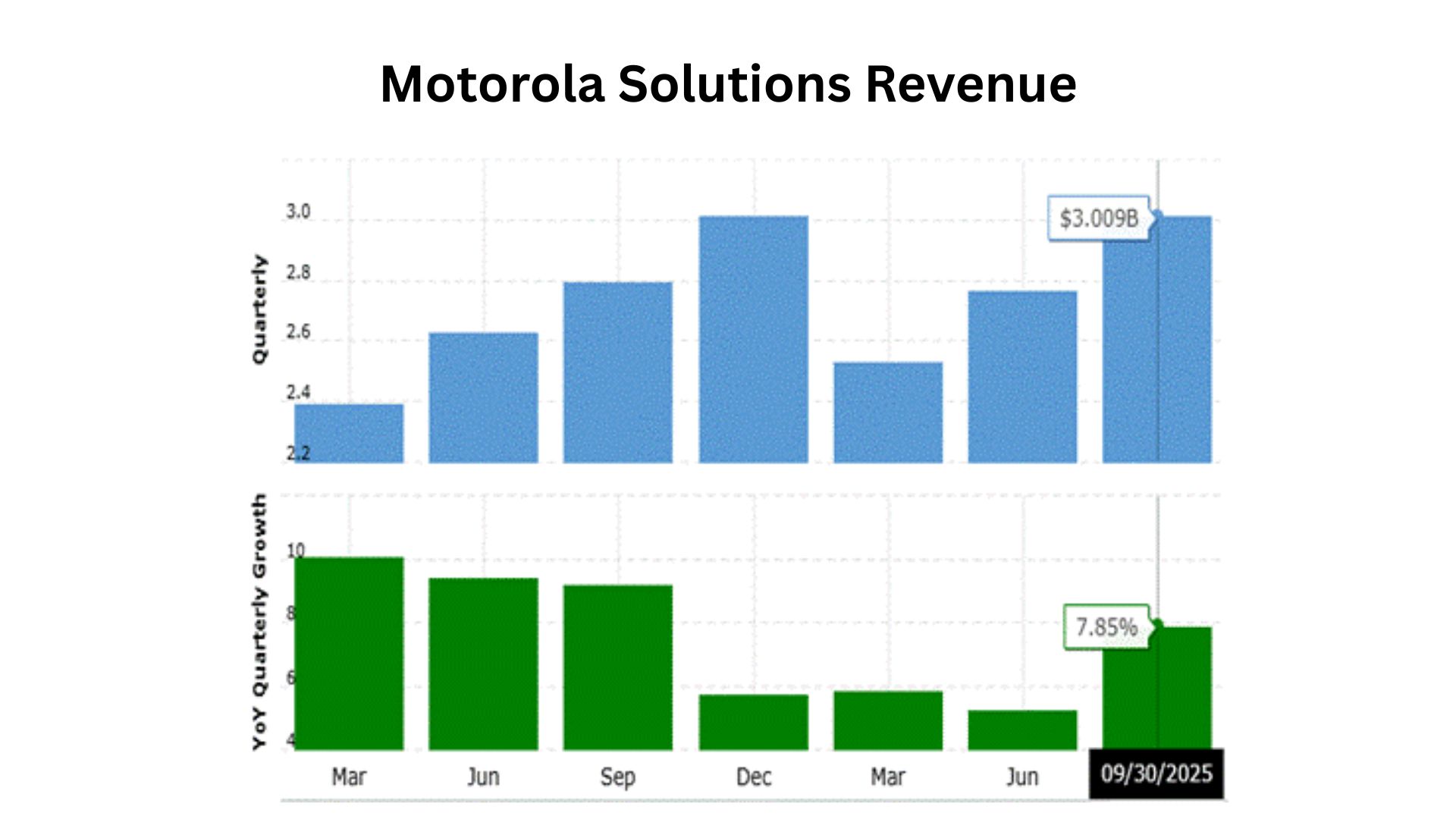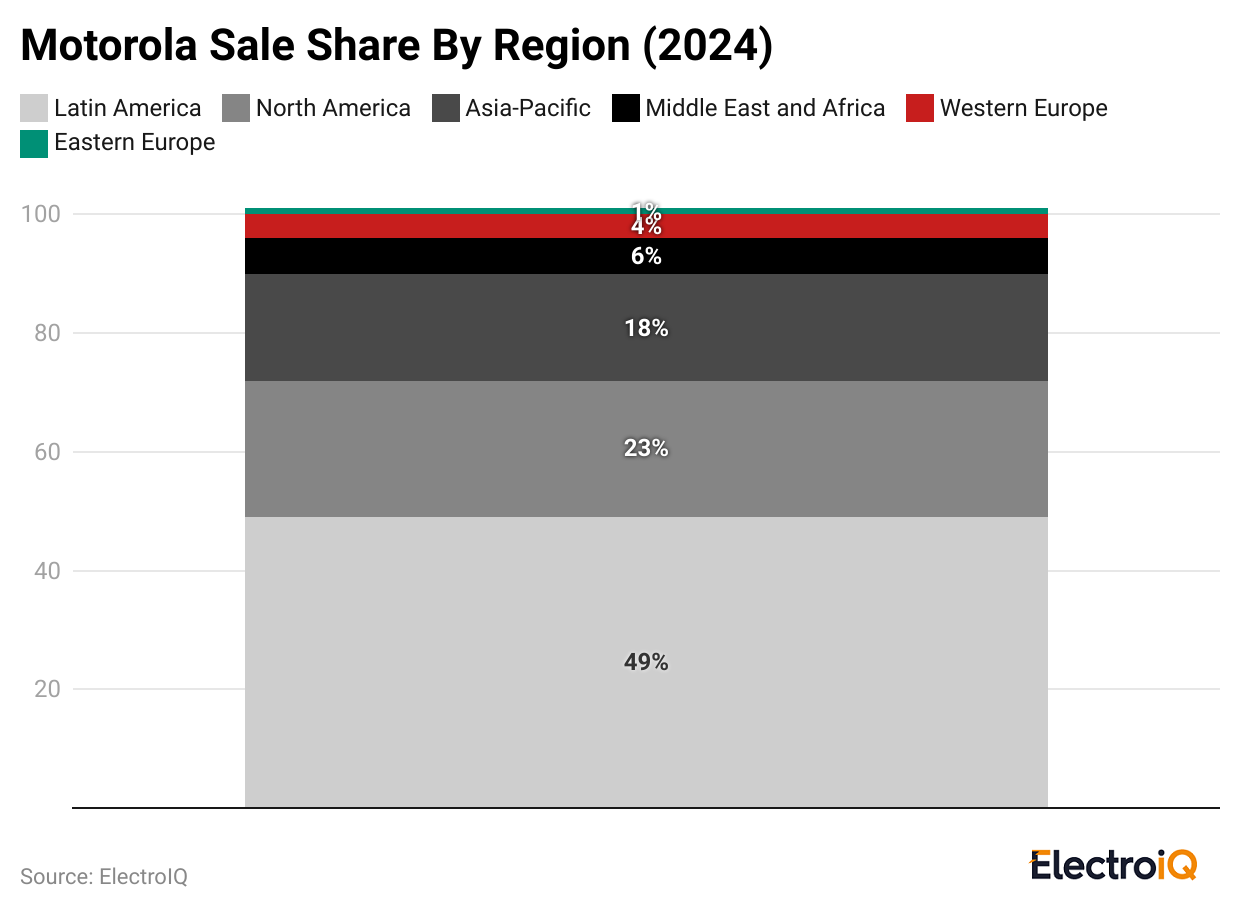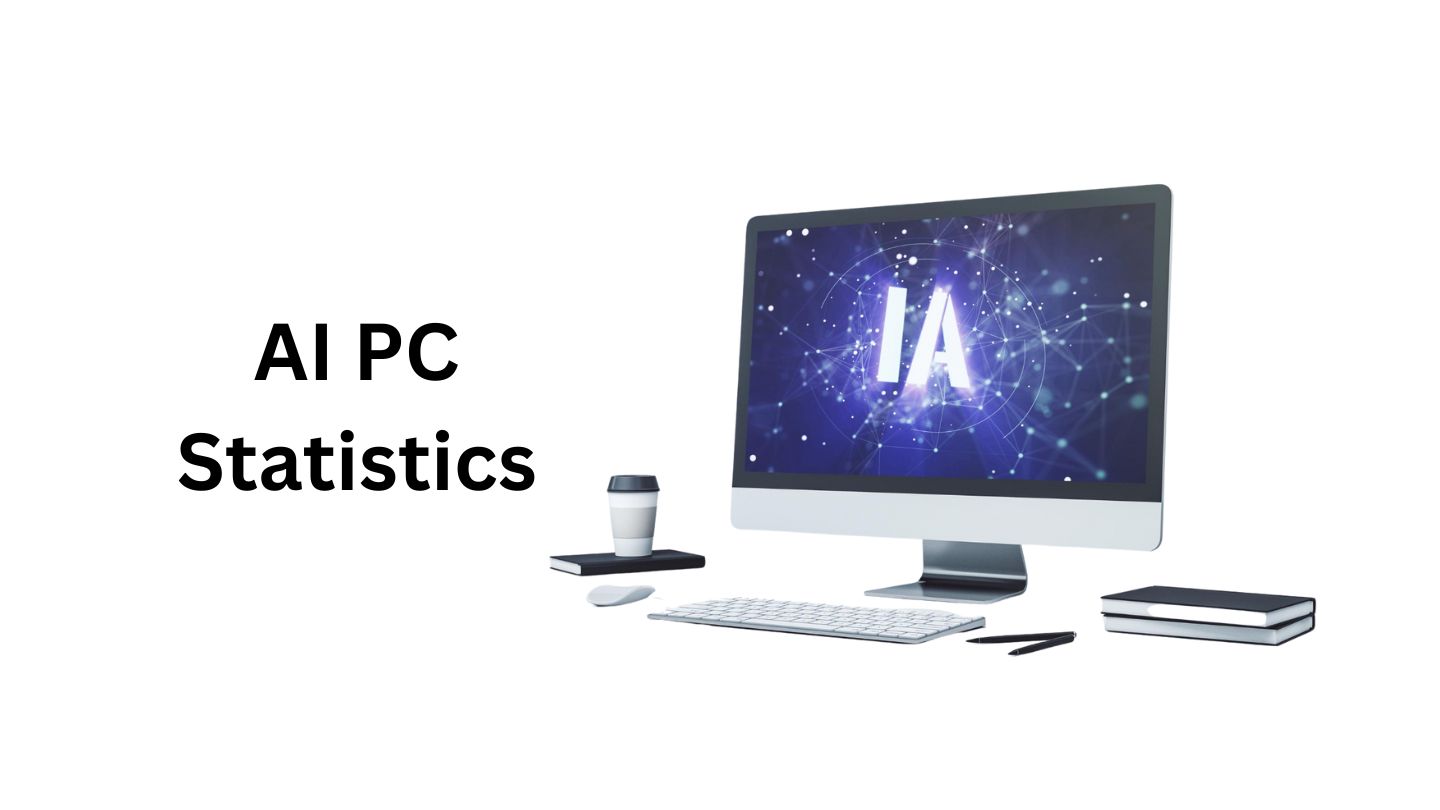Motorola Statistics By Revenue, Sales, Demographics, Market Share and Facts (2025)
Updated · Nov 10, 2025

Table of Contents
- Introduction
- Editor’s Choice
- History of Motorola
- Fun Facts About Motorola
- Financial Analysis of Motorola
- Motorola Solutions Statistics by Revenue
- By Total Assets
- By Shareholder Equity
- By Total Liabilities
- Motorola Smartphones Shipment Statistics
- Motorola Demographic Statistics
- Motorola Smartphones Sales Share Statistics by Region
- Motorola Smartphones Statistics
- Motorola Demographic Statistics by Age, Gender, and Education
- Motorola Users by Income Level
- Motorola Solutions Products Analysis
- Motorola Smartphones Specifications, 2025
- Motorola Patent Statistics
- Conclusion
Introduction
Motorola Statistics: Motorola has shaped communications for decades, from early handheld mobile phones to today’s networks, devices, and services. This Motorola statistics guide consolidates the most important numbers in one place, allowing you to quickly see the company’s size, growth, and direction. We cover revenue, operating profit, net income, cash flow, and spending trends, as well as headcount, regions, and product mix. When helpful, we separate enterprise solutions from the consumer phone business to clearly illustrate the differences. Simple charts and short notes highlight year-over-year changes and why they matter.
This article presents several current insights from diverse perspectives that will remain beneficial for students, analysts, and curious readers alike. These figures provide a quick and reliable snapshot, as well as a foundation for deeper research. Use them to compare segments, benchmark peers, and track momentum over time.
Editor’s Choice
- According to motorolasolutions.com, in Q3 2025, Motorola Solutions reported total sales of USD 3.0 billion, representing an 8% increase from the same period a year earlier.
- According to Growjo.com, Motorola Mobility’s estimated annual revenue is currently USD 9.4 billion in 2025.
- By the end of September 2025, Motorola Solutions’ revenue totalled USD 3.009 billion, representing a 7.85% increase from the previous quarter.
- At the same period, the total assets reached USD 18.799 billion, marking a 35.35% year-over-year increase.
- Meanwhile, the shareholder equity in Q3 2025 was USD 2.344 billion, representing a 74.79% growth rate.
- According to communicationstoday.co.in Motorola’s global smartphone unit sales rose approximately 21% YoY, its best year in a decade.
- In 2024, Motorola’s highest smartphone sales were recorded in Latin America, with a share of 49%.
- According to Zippia, Motorola Solutions employs about 18,000 people.
- Meanwhile, around 30% of the team are women and 70% are men.
History of Motorola
- 1928 — Paul and Joseph Galvin founded Galvin Manufacturing Corporation in Chicago to make battery eliminators.
- 1930 — The first Motorola-branded car radio was introduced; the “Motorola” name combined “motor” and “ola.”
- 1930 — Early public-safety sales began as Illinois police departments adopted Motorola car radios.
- 1937 — The company expanded into larger home radio sets.
- 1941 — Commercial FM mobile two-way radio equipment was introduced; Philadelphia police cars were equipped.
- 1943 — Galvin designed the SCR-300, the world’s first FM portable backpack two-way radio for the U.S. Army; the company also went public.
- 1944 — The first U.S. commercial FM taxi radio system was installed for Yellow Cab in Cleveland.
- 1946 — Motorola equipment carried the first calls on Illinois Bell’s car radiotelephone service in Chicago.
- 1947 — Company name changed from Galvin Manufacturing to Motorola, Inc.; affordable “Golden View” televisions launched.
- 1955 — The iconic “batwing” M logo was introduced.
- 1969 — Motorola S-band transponders relayed Apollo 11 telemetry, voice, and TV from the Moon on July 20.
- 1973 — Martin Cooper placed the first public handheld cellular call using a Motorola DynaTAC prototype in New York on April 3.
- 1983 — The DynaTAC 8000X became the first FCC-approved commercial handheld cell phone in the U.S. (approval Sept 21; market availability in 1984).
- 1986 — Six Sigma was pioneered at Motorola to improve quality; the Bravo pager was introduced.
- 1989 — MicroTAC, then the smallest and lightest phone, was launched.
- 1996 — StarTAC, an influential clamshell mobile, debuted in January.
- 1999 — Motorola agreed to acquire General Instrument, a leading set-top box supplier, in a stock deal around 11 billion dollars.
- 2004 — RAZR V3 launched and went on to sell about 130 million units globally.
- 2004 — Motorola completed the spin-off of its semiconductor arm as Freescale Semiconductor.
- 2011 — Motorola, Inc. split into two listed companies: Motorola Solutions and Motorola Mobility, effective January 4.
- 2012 — Google closed its 12.5 billion-dollar acquisition of Motorola Mobility on May 22.
- 2014 — Lenovo completed its 2.91 billion-dollar acquisition of Motorola Mobility on October 30.
- 2016 — Moto Z was unveiled with magnetically attached “Moto Mods.”
- 2019 — A modern foldable Motorola Razr was announced on November 13.
- 2020 — Motorola disclosed that cumulative Moto G sales since 2013 exceeded 100 million units, reflecting strong mid-range momentum.
Fun Facts About Motorola
- The company was founded on September 25, 1928 in Chicago by Paul V. Galvin and Joseph Galvin as Galvin Manufacturing Corporation.
- The brand name “Motorola” was created for car radios in 1930, combining “motor” and “-ola,” and became the company name in 1947.
- Motorola’s “batwing” logo debuted on June 19, 1955 and was designed by Morton Goldsholl’s Chicago studio; designer Thomas Miller worked on the mark.
- Motorola engineers created Six Sigma quality methodology in 1986, led by Bill Smith.
- The Motorola DynaTAC 8000X became the first FCC-approved commercial portable cellphone in 1983, reaching the market in 1984 at US$3,995 with about 30 minutes of talk time.
- On April 3, 1973, Motorola’s Martin Cooper made the first handheld mobile phone call using a DynaTAC prototype.
- Motorola radios relayed the first words from the Moon on July 20, 1969, via S-band transponders on Apollo 11.
- The SCR-536 “Handie-Talkie” from 1940 is widely regarded as the first mass-deployed handheld two-way radio used by U.S. troops in World War II; Motorola built more than 130,000 units.
- The MicroTAC flip phone launched in 1989, setting the template for compact flip designs that followed.
- The StarTAC arrived in 1996 and is recognized as the first hugely popular clamshell cellphone.
- The RAZR V3 became a global style icon in 2004 and sold more than 130 million units, the best-selling clamshell phone to date.
- Motorola backed the Iridium satellite network, designed for global coverage using 66 low-Earth-orbit satellites; Iridium launched service in 1998 and later restructured after bankruptcy.
- Motorola, Inc. split into two companies on January 4, 2011: Motorola Solutions and Motorola Mobility.
- Google closed its acquisition of Motorola Mobility on May 22, 2012 for US$12.5 billion, then sold the unit to Lenovo on October 30, 2014 for about US$2.9 billion.
- Motorola’s headquarters for Mobility remained in Chicago after the Lenovo deal, underscoring the brand’s longstanding ties to the city.
- The company’s earliest product success was automotive radios that helped popularize in-car entertainment during the 1930s.
- The original DynaTAC “brick” weighed about 790 grams and needed roughly 10 hours to charge.
- Motorola’s public safety communications legacy includes long-running systems like ASTRO and Dimetra, serving government and enterprise users worldwide.
Financial Analysis of Motorola
- According to motorolasolutions.com, in Q3 2025, Motorola Solutions reported total sales of USD 3.0 billion, representing an 8% increase from the same period a year earlier.
- Sales in Products & Systems Integration grew 6%, while Software & Services climbed 11%.
- GAAP EPS came in at USD 3.33, up 1% year over year, and non-GAAP EPS reached USD 4.06, up 9%.
- Operating cash flow reached a new Q3 high of USD 799 million, USD 40 million higher than in the same period last year.
- The order backlog at quarter-end also hit a record USD 14.6 billion, up USD 467 million.
- The company also bought Silvus Technologies for USD 4.4 billion.
The table below shows the financial analysis of previous quarters in 2025 :
| Metrics | Q2 | Q3 |
|
Sales |
USD 2.8 billion, up 5% from last year | USD 2.5 billion (+6% from Q1 2024) |
| Software & Services Sales | Up by 15% year over year |
+9% (from Q1 2024) |
|
GAAP EPS |
USD 3.04, up 17% (YoY) | USD 2.53 |
| Non-GAAP EPS | USD 3.57, up 10% (YoY) |
USD 3.18 (+13% from Q1 2024) |
|
Operating Cash Flow |
USD 272 million, up USD 92 million (YoY) | USD 510 million (USD 128 million YoY) |
| Ending Backlog | USD14.1 billion, up USD 150 million (YoY) |
– |
- According to Growjo.com, Motorola Mobility’s estimated annual revenue is currently USD 9.4 billion in 2025.
- Meanwhile, Motorola Mobility’s estimated revenue per employee is USD 343,000
- Currently, the Motorola Mobility segment has 27317 Employees.
Motorola Solutions Statistics by Revenue

- At Motorola Solutions, the total reported revenue was accounted for USD 3.009 billion as of the end of September 2025, representing a 7.85% increase from the previous quarter.
Furthermore, other quarterly revenue analyses are mentioned below:
| Date | Revenue (USD billion) | Growth Rate |
| 06/30/2025 | 2.765 | +5.21% |
| 03/31/2025 | 2.528 | +5.82% |
| 12/31/2024 | 3.010 | +5.69% |
By Total Assets
- As of 2024, Motorola’s total assets resulted in USD 14.595 billion, representing a 9.44% year-over-year increase.
- Additionally, the total assets decreased to USD 14.433 billion as of March 31, 2025 (still +8.31% YoY), then increased to USD 16.412 billion by June 30, 2025 (+22.98% YoY).
- On September 30, 2025, the total assets accounted for USD 18.799 billion, with a 35.35% increase from last year.
- In the 4th quarter of 2025, Motorola’s shareholder equity totalled USD 1.719 billion, representing a 132.61% increase.
- The equity reduced to USD 1.659 billion in Q1, 2025, though the reported growth rate increased by 208.94%
- Followed by USD 1.984 billion in Q2, 2025 (+142.84%), and USD 2.344 billion in Q3, 2025 (+74.79%).
By Total Liabilities
- On December 31, 2024, Motorola’s total liabilities accounted for USD 12.876 billion (+2.21%).
- Meanwhile, the amount was around USD 12.774 billion as of March 31, 2025 (-0.12%), then increased to USD 14.428 billion by July 30, 2025 (+15.17%).
- The rise continued into the next quarter, reaching USD 16.455 billion on September 30, 2025 (+31.14%).
Motorola Smartphones Shipment Statistics
- According to communicationstoday.co.In Motorola’s global smartphone unit sales rose approximately 21% YoY, its best year in a decade; ASP increased around 17% YoY.
- As per a report published by Light Reading, in the second quarter of 2025, Motorola Mobility shipped around 3.2 million U.S. smartphones, capturing 12%.
- In 2024, India’s market share reached around 5%, making it one of Motorola’s fastest-growing markets.
- In Latin America, Motorola’s shipments declined from 5.9 million in Q4 2024 to 5.2 million in Q1 2025, resulting in a decrease in market share from 17% to 15%.
Motorola Demographic Statistics
- According to Zippia, Motorola Solutions employs about 18,000 people.
- Meanwhile, around 30% of the team are women and 70% are men.
- The largest racial group is White at around 52%, followed by Hispanic or Latino at about 17% and Asian at about 16%.
- On average, an employee earns roughly USD 82,657 per year.
- Politically, employees most often align with the Democratic Party.
- The typical Motorola Solutions employee stays with the company for about seven years.
 (Reference: counterpointresearch.com)
(Reference: counterpointresearch.com)
- As of 2024, Motorola’s highest smartphone sales were captured by the Latin American region with a share of 49%.
- Other shares came from North America (23%), followed by the Asia-Pacific region (18%), the Middle East & Africa (6%), Western Europe (4%), and Eastern Europe (1%).
Motorola Smartphones Statistics
- According to multiple industry reports, Motorola held nearly 4% of the global smartphone market in 2024, maintaining steady performance across the United States and several emerging economies.
- The company’s overall smartphone revenue was reported between USD 9.65 billion and USD 9.7 billion during the same year, reflecting consistent demand for its devices.

- It was noted that Motorola’s focus on mid-range smartphones contributed significantly to its stable market position and user loyalty.
- According to market observers, the Moto G Power 5G and Moto G Stylus 5G were the brand’s two most popular models in 2024, drawing users with their balanced value and performance.
- Approximately 45 million Motorola smartphones were sold globally, reinforcing the company’s relevance in a highly competitive market.
- Around 70% of Motorola devices featured AI-based functions, enhancing the camera quality, battery life, and overall user experience.
- Nearly 85% of Motorola’s lineup was 5G-enabled, ensuring compatibility with next-generation network infrastructure and improved connectivity.
- Reports indicated that 75% of Motorola users actively utilized My UX features, including Moto Actions and Moto Display, which enhance device interaction and personalization.
- Roughly 80% of current Motorola models received security updates within three months of release, demonstrating the company’s commitment to device safety and reliability.
- Close to 60% of its smartphones obtained major Android version updates within six months, showing strong post-launch software support.
- In the U.S. smartphone market, Motorola ranked third, with a 3.98% market share in 2024, as reported by several independent analyses.
- The same reports highlighted that Apple led the market with 59.08%, followed by Samsung with 23.33%, while Google and Xiaomi accounted for 2.56% and 1.24%, respectively.
Motorola Demographic Statistics by Age, Gender, and Education
By Age Group
- According to industry data from 2024, around 40% of Motorola smartphone users were middle-aged individuals between 35 and 50 years.
- Reports also indicate that 25% of users were young adults aged 18 to 25, while approximately 20% belonged to the older adult group aged 50 years and above.
- In the United States, data from 2023 showed that 9% of Motorola smartphone users were between 50 and 64 years, followed by 6% in the 30 to 49 years range and 3% among 18 to 29-year-olds, as reported by national consumer analytics.
By Gender
- Based on recent demographic analysis, male users held the majority share of Motorola smartphone ownership at around 55% in 2024.
- Meanwhile, women represented nearly 45% of total Motorola users worldwide.
- This distribution highlights a slightly stronger preference among men for Motorola’s smartphone range, particularly models known for durability and battery efficiency.
By Educational Background
- According to consumer research studies, about 40% of Motorola users were working professionals, indicating a preference for practical and budget-friendly devices.
- Around 25% of users were students, drawn to affordable models with reliable performance, while 15% were retirees who favored simple and easy-to-use designs.
Motorola Users by Income Level
Low to Middle-Income Consumers
- As reported by market surveys in 2024, more than 50% of Motorola’s global customer base belonged to the low-to-middle-income category.
- These consumers were attracted by the brand’s cost-effective models such as the Moto G Power 5G, priced around USD 300, which delivers dependable performance at an affordable price point.
Middle to Upper-Middle-Income Consumers
- Approximately 40% of users were classified as being in the middle to upper-middle-income bracket.
- This segment prefers feature-rich models like the Moto G Stylus 5G, priced near USD 400, which offer enhanced productivity tools and better processing capabilities suited for multitasking and creative work.
Motorola Users by Regional Distribution
- According to global smartphone distribution data for 2024, the United States remained Motorola’s strongest market, accounting for around 30% of total users.
- India held the second-largest share at approximately 20%, followed by Brazil with 15%.
- Reports also suggest that Mexico represented around 10% of Motorola’s worldwide customer base, reflecting the company’s solid presence across key American and emerging markets.
Motorola Solutions Products Analysis
| Product | Key specifications | Price |
| APX NEXT (P25 smart radio) | All-band (VHF/UHF/700/800), 3.6″ mission-critical touchscreen, SmartConnect (DMR/LTE/Wi-Fi handover), MIL-STD & IP-rated rugged build. | USD 9,877 |
| APX N70 (P25 smart radio) | IP68/MIL-STD 810H rugged, optional LTE + smart apps; APX ecosystem; hardware encryption. | USD 5,014 |
| MOTOTRBO R7 (DMR portable) | UHF/VHF/800/900; 2.4″ display; Bluetooth 5.2; Wi-Fi; IP68/IP66; up to 28-29 hours battery life with high-capacity pack. | USD 1,249 |
| MOTOTRBO Ion (Android smart radio) | Android with open app ecosystem; LTE Bands incl. B1/2/3/4/5/7/8/20/28/38–41; IP68; camera & multimedia. | £1,957 + VAT (new) |
| VB400 (body-worn camera) | 1080p video; up to 12-hour recording; MIL-STD 810G; IP67. | £454 to £545 |
| V700 (LTE body-worn camera) | 1080p recording; dual mics; live LTE streaming; around 12 hour shift battery; 128 GB storage. | USD 32,675 |
| Avigilon H6A PTZ (fixed video, Unity/Alta) | 2 to 4 MP, up to 30× zoom, 360° PTZ views, AI analytics; Unity/Alta integration. | USD 3,728 |
| WAVE TLK 150 (PTT-over-LTE mobile) | LTE + Wi-Fi; location reporting; OTA management; group/private calls. | USD 399 |
Motorola Smartphones Specifications, 2025
| Model Named | Display | Chipset | Memory (base) | Cameras | Battery & charging | Price (USD) |
| Razr Ultra | 7.0″ inner AMOLED (up to 165Hz), 4.0″ outer pOLED | Snapdragon 8 Elite | 16GB / 512GB | 50MP main + 50MP ultrawide; 32MP front | 4700 mAh; up to 68W wired fast charge | 1,299 |
| Razr Plus | 6.9″ 2640×1080 pOLED (165Hz), 4.0″ cover pOLED | Snapdragon 8s Gen 3 | 12GB / 256GB | 50MP main + 50MP 2× telephoto; 32MP front | 4000 mAh; 45W wired, 15W wireless | 999.99 |
| Razr | 6.9″ FHD+ pOLED, 3.6″ cover pOLED | MediaTek Dimensity 7400X | 8GB / 256GB | 50MP main + 13MP ultrawide; 32MP front | 4500 mAh; 30W TurboPower | 699.99 |
| Motorola Edge | 6.7 “Super HD (1220p) pOLED, 120Hz | MediaTek Dimensity 7400 | 8GB / 256GB | 50MP LYTIA 700C + 50MP ultrawide + 10MP telephoto | 5200 mAh; 68W wired, 15W wireless | 549.99 |
| Moto G Stylus | 6.7 “Super HD (1220p) pOLED, 120Hz | Snapdragon 6 Gen 3 | 8GB / up to 256GB | 50MP LYTIA 700C + 13MP ultrawide; 32MP front | 5000 mAh; 68W wired, 15W wireless | 399.99 |
Motorola Patent Statistics
- Motorola Solutions’ SEC and CSR reported that the total global audited patent lists increased from 6,485 on December 31, 2024, to about 7,200 by July 2025.
- Motorola Mobility’s exact global totals aren’t broken out by Lenovo each quarter; however, the 145 U.S. grants were reported by the end of Q1, 2025.
Conclusion
Lastly, Motorola proved to be a confident company, as its revenue secured steady growth with every passing year, margins improved, and a strong cash flow continued to support ongoing investment. As the company serves both enterprise clients and smartphone consumers, the global market is experiencing enormous growth. Its focus on software, services, and AI deepens customer loyalty and adds more recurring sales.
Overall, Motorola appears focused, adaptable, and well-positioned for the next stage of growth. The overall analysis will provide you with a clear understanding of the market.
Sources
FAQ.
Today, Motorola refers to two separate companies: Motorola Solutions (providing technology for businesses and public safety) and Motorola Mobility (manufacturing phones, which is now owned by Lenovo).
Two-way radios, secure networks, video security, and command-centre software for police, fire, and enterprises.
Android smartphones (Moto series), as well as phone apps and accessories.
Motorola phones use Android security patches, while Motorola Solutions enhances encryption, access controls, and compliance for critical public safety users.

Maitrayee Dey has a background in Electrical Engineering and has worked in various technical roles before transitioning to writing. Specializing in technology and Artificial Intelligence, she has served as an Academic Research Analyst and Freelance Writer, particularly focusing on education and healthcare in Australia. Maitrayee's lifelong passions for writing and painting led her to pursue a full-time writing career. She is also the creator of a cooking YouTube channel, where she shares her culinary adventures. At Smartphone Thoughts, Maitrayee brings her expertise in technology to provide in-depth smartphone reviews and app-related statistics, making complex topics easy to understand for all readers.










